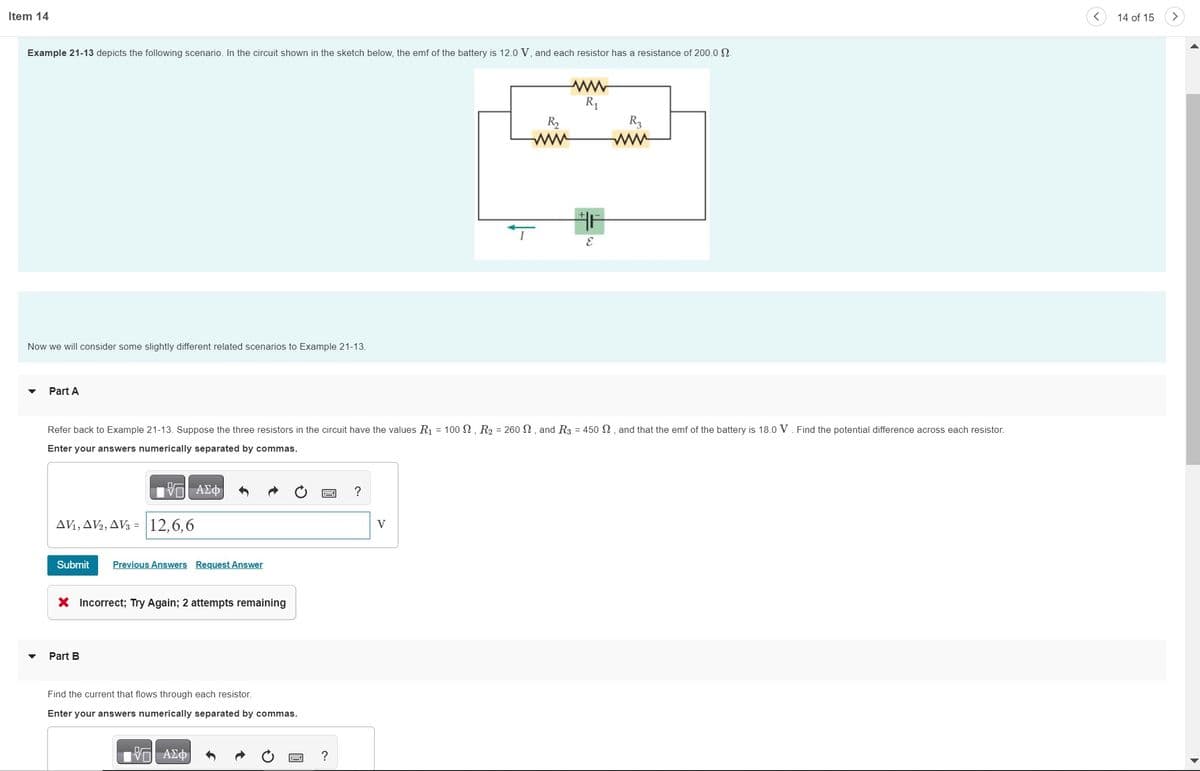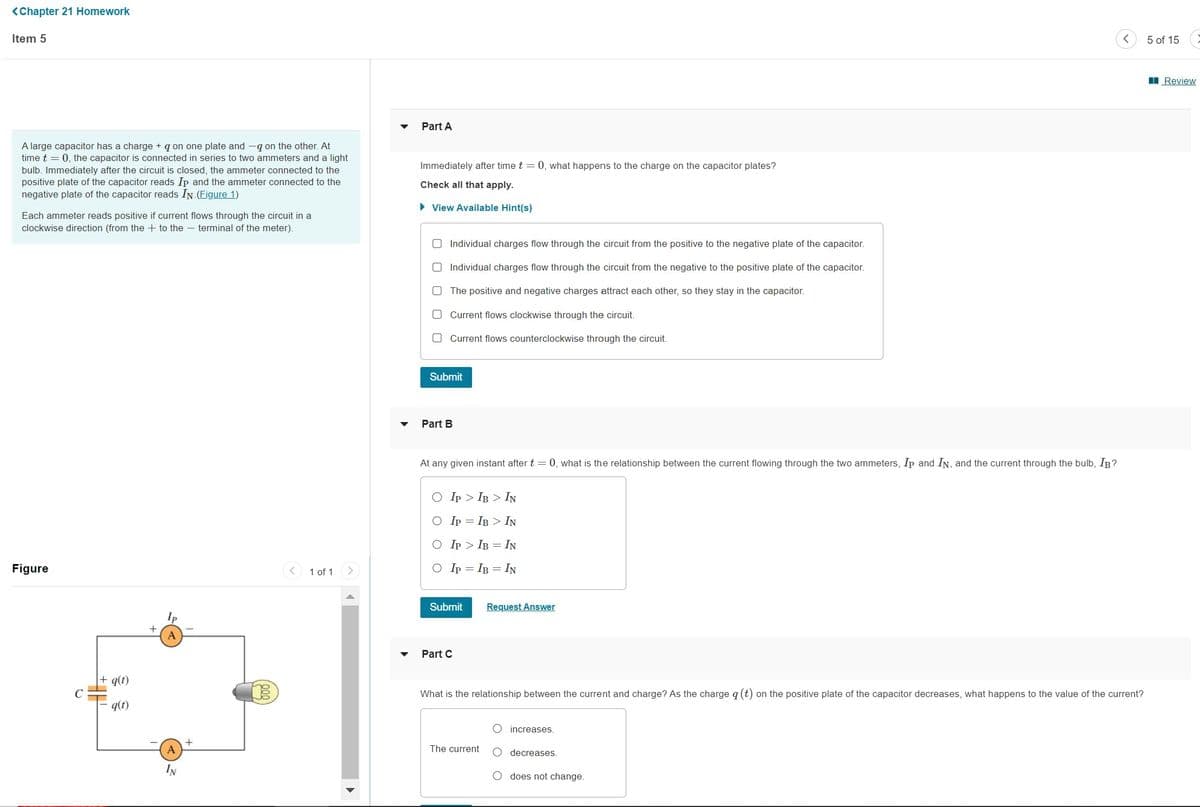Example 21-13 depicts the following scenario. In the circuit shown in the sketch below, the emf of the battery is 12.0 V, and each resistor has a resistance of 200.0 2 Now we will consider some slightly different related scenarios to Example 21-13. ▼ Part A R₂ ww R₂ www Refer back to Example 21-13. Suppose the three resistors in the circuit have the values R₁ = 100 2, R₂ = 260 2, and Rs = 450 , and that the emf of the battery is 18.0 V. Find the potential difference across each resistor. Enter your answers numerically separated by commas.
Example 21-13 depicts the following scenario. In the circuit shown in the sketch below, the emf of the battery is 12.0 V, and each resistor has a resistance of 200.0 2 Now we will consider some slightly different related scenarios to Example 21-13. ▼ Part A R₂ ww R₂ www Refer back to Example 21-13. Suppose the three resistors in the circuit have the values R₁ = 100 2, R₂ = 260 2, and Rs = 450 , and that the emf of the battery is 18.0 V. Find the potential difference across each resistor. Enter your answers numerically separated by commas.
Principles of Physics: A Calculus-Based Text
5th Edition
ISBN:9781133104261
Author:Raymond A. Serway, John W. Jewett
Publisher:Raymond A. Serway, John W. Jewett
Chapter21: Current And Direct Current Circuits
Section: Chapter Questions
Problem 1OQ: If the terminals of a battery with zero internal resistance are connected across two identical...
Related questions
Question

Transcribed Image Text:Item 14
Example 21-13 depicts the following scenario. In the circuit shown in the sketch below, the emf of the battery is 12.0 V, and each resistor has a resistance of 200.0 S.
Now we will consider some slightly different related scenarios to Example 21-13.
Part A
V7| ΑΣΦ)
AV1, AV2, AV3 = 12,6,6
Refer back to Example 21-13. Suppose the three resistors in the circuit have the values R₁ = 100 2, R₂ = 260 , and R3 = 450 2, and that the emf of the battery is 18.0 V. Find the potential difference across each resistor.
Enter your answers numerically separated by commas.
Submit Previous Answers Request Answer
X Incorrect; Try Again; 2 attempts remaining
Part B
Find the current that flows through each resistor.
Enter your answers numerically separated by commas.
195| ΑΣΦ
?
?
www
R₁
V
E
R3
www
14 of 15
>

Transcribed Image Text:<Chapter 21 Homework
Item 5
A large capacitor has a charge + q on one plate and -q on the other. At
time t = 0, the capacitor is connected in series to two ammeters and a light
bulb. Immediately after the circuit is closed, the ammeter connected to the
positive plate of the capacitor reads Ip and the ammeter connected to the
negative plate of the capacitor reads IN (Figure 1)
Each ammeter reads positive if current flows through the circuit in a
clockwise direction (from the to the terminal of the meter).
Figure
q(1)
q(t)
Ip
A
A
1 of 1
Part A
Immediately after time t = 0, what happens to the charge on the capacitor plates?
Check all that apply.
► View Available Hint(s)
O Individual charges flow through the circuit from the positive to the negative plate of the capacitor.
Individual charges flow through the circuit from the negative to the positive plate of the capacitor.
The positive and negative charges attract each other, so they stay in the capacitor.
O
Current flows clockwise through the circuit.
O Current flows counterclockwise through the circuit.
Submit
Part B
At any given instant after t = 0, what is the relationship between the current flowing through the two ammeters, Ip and IN, and the current through the bulb, IB?
O IP
IB IN
O IP
IB > IN
O IP
IB IN
O IP = IB = IN
Submit
Part C
Request Answer
What is the relationship between the current and charge? As the charge q (t) on the positive plate of the capacitor decreases, what happens to the value of the current?
The current
increases.
decreases.
O does not change.
5 of 15
Review
Expert Solution
This question has been solved!
Explore an expertly crafted, step-by-step solution for a thorough understanding of key concepts.
This is a popular solution!
Trending now
This is a popular solution!
Step by step
Solved in 3 steps with 3 images

Knowledge Booster
Learn more about
Need a deep-dive on the concept behind this application? Look no further. Learn more about this topic, physics and related others by exploring similar questions and additional content below.Recommended textbooks for you

Principles of Physics: A Calculus-Based Text
Physics
ISBN:
9781133104261
Author:
Raymond A. Serway, John W. Jewett
Publisher:
Cengage Learning

Physics for Scientists and Engineers, Technology …
Physics
ISBN:
9781305116399
Author:
Raymond A. Serway, John W. Jewett
Publisher:
Cengage Learning

College Physics
Physics
ISBN:
9781938168000
Author:
Paul Peter Urone, Roger Hinrichs
Publisher:
OpenStax College

Principles of Physics: A Calculus-Based Text
Physics
ISBN:
9781133104261
Author:
Raymond A. Serway, John W. Jewett
Publisher:
Cengage Learning

Physics for Scientists and Engineers, Technology …
Physics
ISBN:
9781305116399
Author:
Raymond A. Serway, John W. Jewett
Publisher:
Cengage Learning

College Physics
Physics
ISBN:
9781938168000
Author:
Paul Peter Urone, Roger Hinrichs
Publisher:
OpenStax College

College Physics
Physics
ISBN:
9781305952300
Author:
Raymond A. Serway, Chris Vuille
Publisher:
Cengage Learning


College Physics
Physics
ISBN:
9781285737027
Author:
Raymond A. Serway, Chris Vuille
Publisher:
Cengage Learning